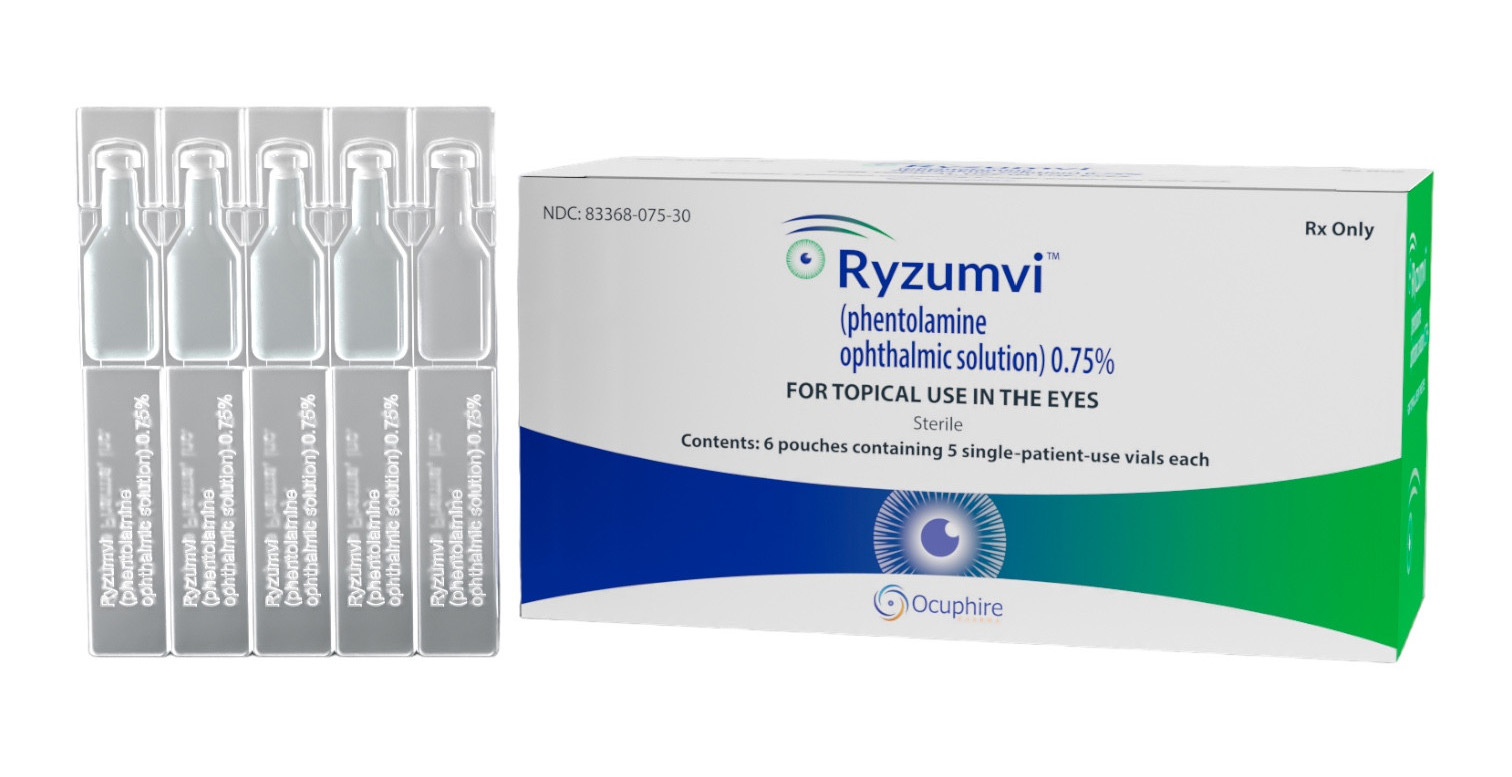 |
|
Ryzumvi restores pupillary reactivity faster and provides a 20% to 25% larger dynamic range of pupil diameter during mesopic to photopic lighting conditions, potentially minimizing glare for those who have to drive after an appointment, the manufacturer’s paper on the Phase III data says. Photo: Ocuphire Pharma. Click image to enlarge. |
Mydriatic agents are workhorse drugs used in everyday eye exam settings, allowing the eyecare practitioner to observe the peripheral retina and other internal structures. However, the experience is notorious for generating patient complains of visual disturbances after dilation, including issues of light sensitivity, glare, blurred vision, cycloplegia, impaired driving and reading difficulty.
To alleviate these issues, researchers have been investigating the use of 0.75% phentolamine ophthalmic solution, an alpha-1 antagonist, in reversing pharmacologically induced mydriasis. Two Phase III double-masked clinical trials were conducted by manufacturer Ocuphire Pharma, with 553 healthy subjects 12 to 80 years old randomized 1:1 (MIRA-2) and 2:1 (MIRA-3) to receive phentolamine or placebo drops OU. The drops were administered one hour after mydriasis, induced by installation of 2.5% phenylephrine, 1% tropicamide or Paremyd (1% hydroxyamphetamine and 0.25% tropicamide).
Results of these company-funded trials were published earlier this week in the Ophthalmology journal in an article written by the drug’s clinical investigators as well as Ocuphire executives.
In MIRA-2, 185 total participants were randomized to receive phentolamine (n=91) or placebo (n=94); in MIRA-3, 368 participants randomly received the drug (n=244) or placebo (n=124). Those treated with phentolamine had study eyes exhibiting a statistically significant greater percentage showing mydriasis reversal (returning to ≤0.2mm greater than baseline pupil diameter) at 90 minutes, which was the primary endpoint, when compared with the placebo. These rates were 48.9% vs. 6.6% for MIRA-2 and 58% vs. 6% for MIRA-3 in those treated with phentolamine or placebo, respectively. Mydriasis reversal occurred in as early as 60 minutes in 24.5% vs. 5.5% for phentolamine and placebo groups in MIRA-2 and 42% vs. 2% in MIRA-3. After 24 hours of pharmacological dilation, between 28% to 34% of placebo-treated patients had not returned to baseline pupil diameter, whereas this was only 8% to 11% in those treated with the agent.
The phentolamine drops represent a statistically significant time savings of three to four hours to return of baseline pupil diameter, the authors contend, and one or two drops of the agent reversed dilation in all participants, regardless of mydriatic agent or iris color. Those who received the agent also reported perceived resolution of visual symptoms caused by the dilation. Along with these promising data, the safety profile of phentolamine was good, with most adverse events being mild, and including mild transient conjunctival hyperemia (11.2%), instillation site discomfort (10.9%) and dysgeusia (3.6%).
Due to the higher percentage of eyes in both MIRA-2 and MIRA-3 returning to baseline at 90 minutes than in the placebo group at six hours, the study investigators consider “this is quite significant when considering that many subjects return to work or school after their appointment and [phentolamine ophthalmic solution] could offer approximately five or more hours of productivity, comfort and safety.”
Another benefit of employing this agent would be restoring pupillary reactivity to light and consequent reduction in glare and photophobia, as these can affect driving. As the investigators elaborate, “post-dilation, glare is a significant concern for drivers who must perform under constantly changing lighting conditions, as it can severely impair vision and increase the risk of accidents.”
Overall, the researchers were able to generalize that “both treatment doses were well tolerated, supporting a rapid and safe reversal of pharmacologically induced mydriasis across various agents and iris types.”
| Click here for journal source. |
Pepose JS, Wirta D, Evans D, et al. Reversal of pharmacologically induced mydriasis with phentolamine ophthalmic solution. Ophthalmology. September 16, 2024. [Epub ahead of print]. |


